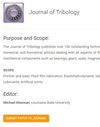考虑非平衡轴-轴承系统的外套圈缺陷轴承动力学模型与实验仿真
IF 3
3区 工程技术
Q2 ENGINEERING, MECHANICAL
引用次数: 0
摘要
本文研究了非平衡条件下轴承外圈缺陷尺寸的演变和转速的增加对轴-轴承系统振动特性的影响。考虑了套圈与球之间的接触刚度,并在模型中加入了一系列的弹簧。采用赫兹接触变形理论计算接触刚度。该模型考虑了球与套圈之间的接触变形、球与内套圈之间由于径向间隙和缺陷几何造成的额外位移。利用沟槽半径、球半径和缺陷直径,解析计算了球进入缺陷的最大可能径向位移。矩形函数用于对缺陷进行建模。开发了用于轴-轴承系统建模和用龙格-库塔法求解运动微分方程的MATLAB代码。通过模拟和实验得到的振动响应显示出相似的振动特性。研究表明,随着缺陷尺寸的增大,统计参数的值先增大后减小。峰系数和均方根随速度增大而增大,峰系数和峰度随速度增大而减小。Peak对外种的斑点及其演化的诊断更为敏感。本研究有助于有效诊断在不平衡条件下外圈有碎片的减摩轴承。本文章由计算机程序翻译,如有差异,请以英文原文为准。
A dynamic model of outer race defective bearing considering the unbalanced shaft-bearing system with experimental simulation
In this study, the effects of the evolution of bearing outer race defect size and increase in speed on the vibration characteristics of a shaft-bearing system under unbalanced conditions. The contact stiffness between the races and the balls is considered as a series of springs is also incorporated in the model. Hertzian contact deformation theory is used to obtain the contact stiffness. This model considers the contact deformation between the balls and the races, the additional displacement between the balls and the inner race due to radial clearance, and due to defect geometry. The maximum possible radial displacement of the ball into the defect is calculated analytically using the groove radius, ball radius and defect diameter. The rectangular function is used for modelling the defect. MATLAB codes are developed for modelling the shaft-bearing system and for solving the differential equations of motion using the Runge-Kutta method. The vibration responses obtained by modelling and by experimentation show similar vibration characteristics. The investigation shows that the values of statistical parameters initially increase with the increase in defect size and then decrease with a further increase in defect size. While peak and RMS increase with the speed and crest factor and kurtosis decrease with an increase in speed. Peak is more sensitive for diagnosing spalls on outer race and its evolution. This study helps as an effective diagnosis of antifriction bearings having spalls on the outer race under unbalanced conditions.
求助全文
通过发布文献求助,成功后即可免费获取论文全文。
去求助
来源期刊
CiteScore
4.20
自引率
12.00%
发文量
117
审稿时长
4.1 months
期刊介绍:
The Journal of Tribology publishes over 100 outstanding technical articles of permanent interest to the tribology community annually and attracts articles by tribologists from around the world. The journal features a mix of experimental, numerical, and theoretical articles dealing with all aspects of the field. In addition to being of interest to engineers and other scientists doing research in the field, the Journal is also of great importance to engineers who design or use mechanical components such as bearings, gears, seals, magnetic recording heads and disks, or prosthetic joints, or who are involved with manufacturing processes.
Scope: Friction and wear; Fluid film lubrication; Elastohydrodynamic lubrication; Surface properties and characterization; Contact mechanics; Magnetic recordings; Tribological systems; Seals; Bearing design and technology; Gears; Metalworking; Lubricants; Artificial joints

 求助内容:
求助内容: 应助结果提醒方式:
应助结果提醒方式:


